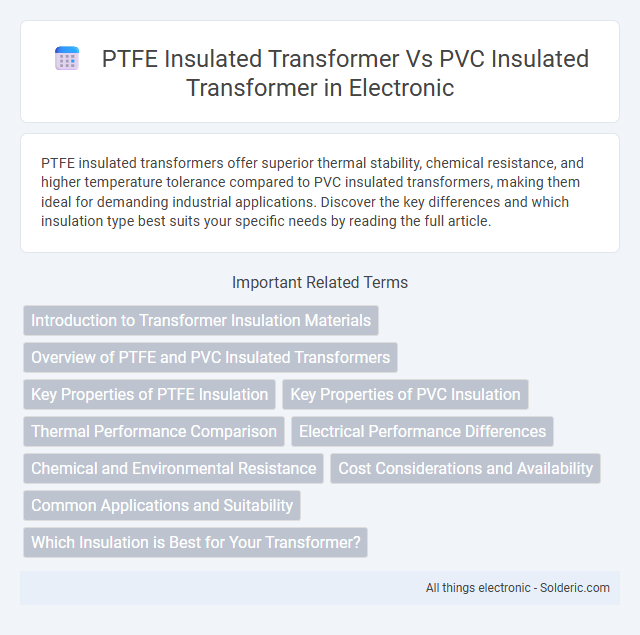PTFE insulated transformers offer superior thermal stability, chemical resistance, and higher temperature tolerance compared to PVC insulated transformers, making them ideal for demanding industrial applications. Discover the key differences and which insulation type best suits your specific needs by reading the full article.
Comparison Table
| Feature | PTFE Insulated Transformer | PVC Insulated Transformer |
|---|---|---|
| Insulation Material | Polytetrafluoroethylene (PTFE) | Polyvinyl Chloride (PVC) |
| Temperature Resistance | Up to 260degC | Up to 70degC - 105degC |
| Chemical Resistance | Exceptional resistance to chemicals and solvents | Moderate chemical resistance |
| Flame Retardance | Self-extinguishing, high flame retardance | Moderate flame retardance, may require additives |
| Mechanical Properties | Flexible, durable, with excellent wear resistance | Less flexible, more prone to cracking under stress |
| Cost | Higher cost due to superior properties | Lower cost, widely used in general applications |
| Applications | High-temperature, chemical, and harsh environment use | Standard electrical and general industrial use |
| Lifespan | Long-lasting, resistant to aging and degradation | Shorter lifespan, susceptible to environmental damage |
Introduction to Transformer Insulation Materials
PTFE insulated transformers utilize polytetrafluoroethylene as their insulation material, distinguished by its high thermal stability, chemical resistance, and excellent dielectric properties, making them suitable for demanding industrial and high-frequency applications. PVC insulated transformers, on the other hand, feature polyvinyl chloride insulation, known for its cost-effectiveness, flexibility, and adequate electrical insulation for general-purpose and low-temperature environments. The choice between PTFE and PVC insulation directly impacts the transformer's performance, longevity, and suitability for specific operating conditions, with PTFE offering superior durability under extreme thermal and chemical stresses.
Overview of PTFE and PVC Insulated Transformers
PTFE insulated transformers use polytetrafluoroethylene for insulation, offering superior thermal stability, chemical resistance, and a higher temperature rating up to 260degC, making them ideal for high-performance and harsh environments. PVC insulated transformers feature polyvinyl chloride insulation, which provides adequate protection and cost-effectiveness with a maximum operating temperature around 105degC, suitable for general-purpose applications. The choice between PTFE and PVC insulation significantly impacts durability, thermal tolerance, and overall transformer lifespan in varying industrial conditions.
Key Properties of PTFE Insulation
PTFE insulation offers superior thermal resistance, withstanding temperatures up to 260degC, compared to PVC insulation's limit around 105degC, making it ideal for high-temperature environments. Its excellent chemical resistance and low dielectric constant enhance the efficiency and longevity of transformers by minimizing electrical losses and degradation. Your transformer benefits from PTFE's non-flammability and outstanding mechanical strength, ensuring reliable performance in demanding industrial applications.
Key Properties of PVC Insulation
PVC insulation in transformers offers excellent durability, high mechanical strength, and effective resistance to water, chemicals, and flame, making it a reliable choice for various industrial applications. It provides good electrical insulation with a wide operational temperature range typically up to 70degC to 105degC, though it may degrade faster under extreme heat compared to PTFE insulation. Your selection might favor PVC insulation for cost-efficiency and ease of installation where moderate thermal and environmental resistance suffices.
Thermal Performance Comparison
PTFE insulated transformers exhibit superior thermal performance due to PTFE's high melting point of approximately 327degC and excellent thermal stability, allowing operation at elevated temperatures without degradation. In contrast, PVC insulated transformers typically have a maximum operating temperature around 105degC, limiting their suitability for high-heat environments. PTFE insulation also offers lower thermal conductivity, enhancing heat dissipation and efficiency in transformer applications.
Electrical Performance Differences
PTFE insulated transformers exhibit superior electrical performance due to their high dielectric strength (up to 60 kV/mm) and excellent thermal stability, enabling operation in extreme temperatures without insulation degradation. PVC insulated transformers typically offer lower dielectric strength (around 40 kV/mm) and reduced thermal resistance, leading to higher leakage currents and potential insulation failure under high load conditions. The reduced dielectric losses and greater resistance to electrical tracking in PTFE insulation significantly improve the transformer's efficiency and longevity compared to PVC.
Chemical and Environmental Resistance
PTFE insulated transformers exhibit superior chemical resistance, effectively withstanding exposure to aggressive solvents, acids, and alkalis, making them ideal for harsh industrial environments. PVC insulated transformers offer moderate chemical resistance but are more susceptible to degradation from oils, hydrocarbons, and UV radiation. PTFE insulation also provides excellent environmental resistance, maintaining performance in extreme temperatures and minimizing environmental impact due to its non-toxic and recyclable properties.
Cost Considerations and Availability
PTFE insulated transformers generally carry a higher upfront cost due to the superior thermal and chemical resistance of PTFE materials compared to PVC insulation, which is more widely available and economical. PVC insulated transformers are commonly used in standard applications where budget constraints are critical and operating environments are less demanding. Availability of PTFE insulated transformers is more limited, often restricted to specialized suppliers, whereas PVC insulated transformers are mass-produced and readily accessible in the global market.
Common Applications and Suitability
PTFE insulated transformers are commonly used in high-frequency and high-temperature environments, such as aerospace, medical devices, and military electronics, due to their excellent thermal stability and chemical resistance. PVC insulated transformers are more suitable for general-purpose applications like household appliances, lighting, and low-voltage equipment because of their cost-effectiveness and good insulating properties under moderate temperature conditions. PTFE insulation offers superior durability in harsh conditions, while PVC insulation provides reliable performance in everyday electrical systems.
Which Insulation is Best for Your Transformer?
PTFE insulated transformers offer superior thermal stability, chemical resistance, and a higher temperature rating of up to 260degC compared to PVC insulated transformers, which typically withstand temperatures up to 105degC and provide basic electrical insulation. Your choice depends on the operating environment; PTFE insulation is ideal for high-temperature, harsh chemical, or demanding industrial applications, while PVC insulation suits standard low to medium temperature settings with moderate flexibility needs. Evaluating factors like thermal endurance, mechanical durability, and budget constraints will help determine the best insulation type for your transformer.
PTFE insulated transformer vs PVC insulated transformer Infographic

 solderic.com
solderic.com